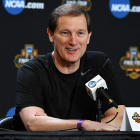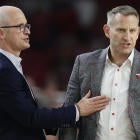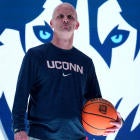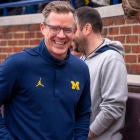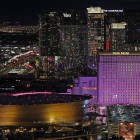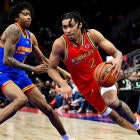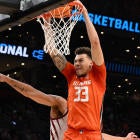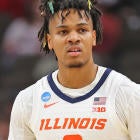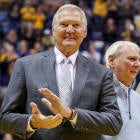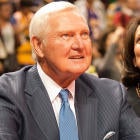GLENDALE, Arizona -- The West Coast needed this Final Four. Just ask the guys who made it so.
In certain precincts of the collective basketball mind, the perception had been the West Coast was definitely not the Best Coast.
“I heard it my whole life,” said Oregon guard Tyler Dorsey, a Los Angeles native. “I used to play back East against New York guys since I was a little kid.
“The West Coast is definitely not soft. The basketball is up-tempo. We play fast, we score.”
Soft? That, from a team that clubbed top-seeded Kansas basically in its own crib in the regional final.
But the message is clear in this Final Four. Oregon and Gonzaga -- and by extension their conferences and their regions -- can play. Consider their appearance here a breakthrough. There has never been a pair of teams from the Pacific Time Zone in the Final Four.
The last time there were two Final Four teams from West of the Rockies was 1998 (Stanford and Utah).
Since 2008, only UCLA (three straight years 2006-2008) has made it this far from the West Coast. That’s nine years without a shout out to the left side of the country.
Some of the reasons are obvious. Basketball is traditionally East Coast-based. The game grew out of that region’s population centers. Tobacco Road rules. North Carolina is making its 20th Final Four appearance.
But if there can be rap battles between East Coast and West Coast, basketball styles can be compared too.
“We have regional definitions for hoopers,” Gonzaga’s Jordan Mathews said Thursday from the Zags locker room.

Mathews, another L.A. native, has heard all the stereotypes.
“California, they can shoot. People think they’re soft. New York, they dribble a lot to every shot. Texas, they’re going to be athletic. Florida, they’re going to be athletic but they’re going to do a little bit of everything.”
The pride of Long Beach, California, Oregon forward Jordan Bell, brought it up on the floor of the Sprint Center on Saturday.
“We’re not sweet. Everybody thinks we’re sweet over here on the West Coast.”
Sweet?
“That we’re soft,” Bell continued. “I think we’re just as tough as anybody else here in the country. I think we proved that. West Coast is the Best Coast.”
Someone (else) had to say it.
How it ever got this way is a jump ball. UCLA defined the college game in the 1960s and 1970s. Later, the Big East took over on a national scale, a conference formed out of East Coast powerhouses in 1979 to dominate the hardcourt and television.
Conference realignment sometimes ignored geography. The old Big East is now divided up between the basketball-only league that kept the original name and the American Athletic Conference.
West Virginia was a couple of bounces away this month from representing the Big East and the Big 12 in the Final Four within an eight-year period.
The rise of the mid-major dug into the turf of traditional powers. Before Gonzaga there was VCU, George Mason and Butler in the Final Four.
It took the Zags’ Mark Few 18 years to break through. To call Gonzaga a mid-major at this point borders on heresy. The Zags have been to 19 straight NCAA tournaments. This is their first Final Four.
The roster is populated with seven West Coast players if you include backup Dustin Triano from Vancouver, British Columbia. Oregon has eight such players.
South Carolina and North Carolina have a combined zero from the West. So add another possibility -- the first all-West Coast championship game.
“I don’t get into the whole regional thing to be honest with you,” Few said. “I have good friends, buddies that coach all over.
“It doesn’t seem to be that big of a deal to me going down the stretch which made me think about it more. [In the past], we just didn’t negotiate the crap shoot that is the NCAA Tournament to get to the Final Four.”

At Oregon, basketball was almost an afterthought as Phil Knight used the school’s athletics to build his global Nike brand.
Football has been to the national championship game twice since 2010. It enjoyed its best four-year run from 2009-2012 under Chip Kelly.
But this week might mark the crowning achievement in school’s athletic history. That is, if you don’t count 10 combined men’s track national championships. Football and basketball are the sports that make money for a school tucked up in a rural area of the Pacific Northwest.
The Final Four is “a lot more special to me, just because I was involved in this thing for so long,” said Pat Kilkenny, an influential booster and former Oregon athletic director. “The football thing is great and I love Chip. But it just wasn’t as personal to me.
“This is something … I had a dream.”
Knight and Kilkenny, a self-made insurance millionaire, are Oregon’s two primary boosters. “Kilkenny Floor” graces Oregon’s Matthew Knight Arena.
The last time Oregon played in the Valley of the Sun for a national championship in 2010, Nike famously shot a laser image of a giant swoosh on the side of Camelback Mountain. That was the night before the Ducks lost to Auburn in the 2011 BCS title game.
What better marketing scheme for Nike this time than to win it all in hoops? Knight’s company is known to have a few bucks invested in manufacturing basketball shoes.
“Basketball in the West is underrated, which is understandable,” Knight told CBS Sports. “Our games are on about 1 a.m. on the East Coast. They don’t know what’s going on out there.”
Well, yes, there’s that. But don’t blame Larry Scott, the Pac-12 commissioner, who has openly lobbied for earlier start times. The thing is, when you sell your rights to networks they get to set the starting times to maximize ratings.
Hall of famer Bill Walton -- a UCLA All-American -- has reinvented himself as a quirky advocate for West Coast basketball as a broadcaster. Love him or hate him, you’re probably going to watch him go down some rabbit hole on a regular basis.
“I think they really sleep on West Coast basketball in my opinion,” Dorsey said. “Hopefully they woke up after this [Kansas] game and see how big West Coast basketball is.”
Arizona coach Sean Miller -- for better or worse -- is quickly becoming the best coach never to make a Final Four. His Wildcats have come agonizingly close in recent years, advancing to three Elite Eights since 2011.
At Oregon, it took an unassuming everyman from Crete, Nebraska, to rebrand the Ducks. Dana Altman, 58, already had won 327 games at Creighton when he was hired in 2010.
When Ernie Kent was fired in 2010, the administration took 39 days to replace him.
Oregon talked to Tom Izzo, then-Missouri coach Mike Anderson, then-Pittsburgh coach Jamie Dixon and Butler’s Brad Stevens. They settled on Altman, a fourth choice at best.
Slowly, steadily, Oregon plowed to the top of the Pac-12, winning at least a share of the conference in consecutive years.
“It got really, really important to find a man who could lead us to the promised land,” Kilkenny said. “Dana is “one of the best people I’ve ever met in my life.”
Hugging Altman on the floor after the regional championship Saturday, Kilkenny sobbed into his coach’s ear.
“I’m just so f------ happy.”
West Coast? UCLA and Arizona got more attention during the season. The Ducks’ roster sports three Canadians, including No. 2 rebounder Chris Boucher out for the season with a knee.
Dillon Brooks, a Canadian from Ontario, was the Pac-12 player of the year. But a different pride beats in the hearts of Bell and Dorsey, both Californians.
“Ever since I’ve been growing up, ever since I started travel ball,” Bell said. “You can tell by people’s attitude. They think the West Coast is soft. I’ve been hearing that my whole life. Ain’t nothing soft over here.”












